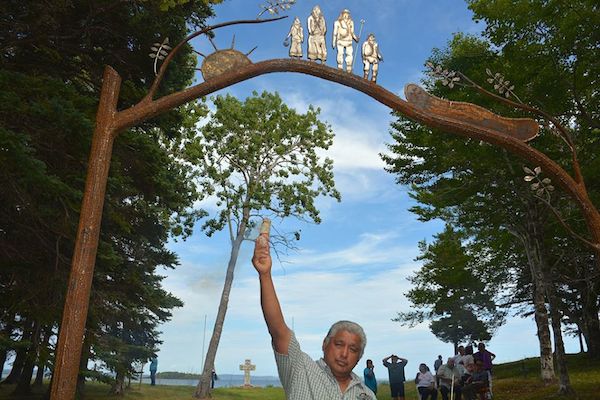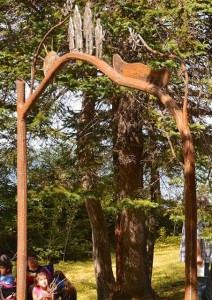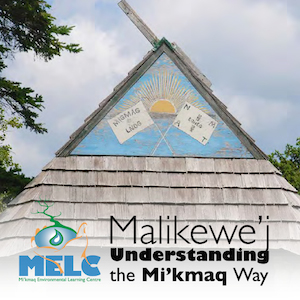
Mala, as it is affectionately known to the Cape Breton Mi’kmaq who share it, is off the beaten track, and its serenity is only broken by the call of the eagles who share it with the handful of residents. It is unique in that it is shared jointly by the five bands in Unama’ki (Cape Breton), and has been used by the Mi’kmaq people as a gathering place and burial grounds for generations.
At this past weekend’s annual outdoor mass, the residents had a few new things to celebrate with the publication of a new booklet on the history and people of Malikewe’j, and a ribbon cutting for a permanent monument.
Project coordinator Nadine Lefort elaborates on the process that led to the monument. “It was created through a gathering and conversation with Malikewe’j residents and Elders, with Cape Breton artist Gordon Kennedy. A metal archway, at the entrance to the graveyard, commemorates people who lived and are buried there, honours those who continue to live in Mala, and those who will live there in the future.”

UINR’s Senior Advisor Charlie Dennis explains. “This monument reminds us of our traditions, helping us reconnect with the world around us in a way that encourages netukulimk and our Mi’kmaq ways.”
The project was funded by the Mi’kmaq Cultural Activities Program of the Nova Scotia Department of Communities, Culture and Heritage.
In addition to the monument, a new publication, Malikewe’j: Understanding the Mi’kmaq Way was released on Sunday, August 31 at the community’s annual outdoor mass.
The book, written by Nadine Lefort with Charlie Dennis, tells the story of Malikewe’j through photos, illustrations, and stories from long-time Mala residents.
 “It discusses the special cultural and spiritual relationships Mi’kmaq people have with Malikewe’j and looks at Mi’kmaq Grand Council’s traditional role in resource management, with lessons on how to re-establish the ‘Mi’kmaq Way’ as the community caretakers,” says Lefort. “A project of MELC-Mi’kmaq Environmental Learning Centre and Mi’kmaw Kina’matnewey, funding and support was provided by Mi’kmaw Kina’matnewey, Parks Canada/Parcs Canada and UINR–Unama’ki Institute of Natural Resources.”
“It discusses the special cultural and spiritual relationships Mi’kmaq people have with Malikewe’j and looks at Mi’kmaq Grand Council’s traditional role in resource management, with lessons on how to re-establish the ‘Mi’kmaq Way’ as the community caretakers,” says Lefort. “A project of MELC-Mi’kmaq Environmental Learning Centre and Mi’kmaw Kina’matnewey, funding and support was provided by Mi’kmaw Kina’matnewey, Parks Canada/Parcs Canada and UINR–Unama’ki Institute of Natural Resources.”
The Mi’kmaq Environmental Learning Centre is a community organization whose mission is to provide leadership and share knowledge on local natural resource management based on traditional values and perspectives. Established in 2010 as a tribute to Mi’kmaq Elders, MELC is sharing this report of traditional Mi’kmaq knowledge on Malikewe’j and environmental management.
Mi’kmaw Kina’matnewey is a team of chiefs, staff, parents, and educators who advocate on behalf of and represent the educational interests of Mi’kmaq communities, protecting the educational and language rights of Mi’kmaq people. Mi’kmaw Kina’matnewey works to improve the quality of Mi’kmaq education, remaining vigilant in maintaining and revitalizing Mi’kmaq language.
Unama’ki Institute of Natural Resources (UINR) represents the five Mi’kmaq communities in Unama’ki on natural resource issues. UINR contributes to an understanding and protection of the Bras d’Or Lakes’ ecosystem through research, monitoring, education, management, and by integrating Mi’kmaq and conventional ways of understanding, known as Two-Eyed Seeing.
Responding to community and Elders’ concerns, UINR works to protect Malikewe’j and preserve its heritage.

